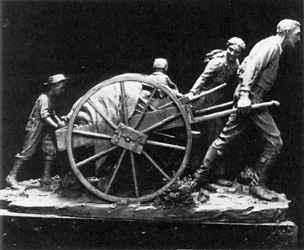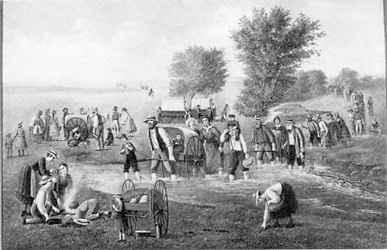
Handcart Companies |

The Handcart Family, by Torlief Knaphus (1926, life sized bronze), Temple Square, Salt Lake City. This statue on Temple Square commemorates the faith and sacrifice of 2,962 mormon pioneers who walked from Iowa and Nebraska to Utah, pushing and pulling handcarts loaded with their provisions and belongings. Courtesy Utah State University.
by Howard A. Christy
The large backlog of needy LDS converts awaiting passage from Europe and reduced tithing receipts at home persuaded Brigham Young in 1855 to instruct that the "poor saints" sailing from Liverpool to New York and taking the train to Iowa City should thence "walk and draw their luggage" overland to Utah. In 1856 five such mormon pioneer handcart companies were organized to make the 1,300-mile trip on foot from the western railroad terminus at Iowa City to Salt Lake City (see Immigration and Emigration; Mormon Trail).
Success seemed assured when the first two companies, totaling 486 immigrants pulling 96 handcarts, arrived safely in Salt Lake City on September 26, 1856. They accomplished the trek in under sixteen weeks. The third company, and presumably the last of the season, made up of 320 persons pulling 64 handcarts, arrived on October 2. But at that point the two remaining companies, totaling 980 people and 233 handcarts, were still on the way, having started dangerously late. One of these companies, under James G. Willie, left Iowa City on July 15, crossed Iowa to Florence (Omaha), Nebraska, then, after a week in Florence, headed out onto the plains. The last company, under Edward Martin, departed Florence on August 25. Three independent wagon companies, carrying 390 more immigrants, also started late.
A week after the departure of the Martin Company, Franklin D. Richards, an apostle who had organized the handcart effort as president of the European Mission, also departed Florence with sixteen other returning missionaries. This party, on horseback and in fast carriages, passed the Martin Company on September 7, the Willie Company on September 12, and arrived in Salt Lake City on October 4.
Richards's report that many more immigrants were coming was a shock: the late-starting immigrants would not be adequately clothed for the cold weather they would surely experience; they, like those in all previous lightly supplied handcart companies, would be perilously short of food; and, as they were unexpected, the last resupply wagons, which were routinely dispatched into the mountains to meet immigrant companies, had already returned.
Anticipating the worst, President Young mobilized men and women gathered for general conference and immediately ordered a massive rescue effort. A party of twenty-seven men, led by George D. Grant, left on October 7 with the first sixteen of what ultimately amounted to 200 wagons and teams. Several of the rescue party, including Grant, had been among the missionaries who had ridden in from the East five days before.
Two weeks later, one of the earliest blizzards on record struck just as both the handcart companies and the independent wagon companies were entering the Rocky Mountains in central Wyoming. After several days of being lashed by the fierce blizzard, people in the exposed handcart companies began to die.
Grant's rescue party found the Willie Company on October 21—in a blinding snowstorm one day after they had run out of food. But the worst still lay ahead, when, after a day of rest and replenishment, the company had to struggle over the long and steep eastern approach to South Pass in the teeth of a northerly gale. Beyond the pass, the company, now amply fed and free to climb aboard empty supply wagons as they became available, moved quickly, arriving in Salt Lake City on November 9. Of the 404 still with the company, 68 died and many others suffered from severe frostbite and near starvation.
Those of the Martin Company, three-fourths of them women, children, and the elderly, suffered even more. When the storm hit on October 19, they made camp and spent nine days on reduced rations waiting out the storm. Grant's party, after leaving men and supplies with the Willie Company, plunged farther east through the snow with eight wagons in search of the Martin Company. A scouting party sent out ahead of the wagons found them 150 miles east of South Pass.
The company, already in a desperate condition, was ordered to break camp immediately. The supply wagons met them on the trail, but the provisions were not nearly enough and, after struggling 55 miles farther, the company once again went into camp near Devil's Gate to await the arrival of supplies.
In the meantime, the rescue effort began to disintegrate. Rescue teams held up several days by the raging storm turned back, fearing to go on and rationalizing that the immigrant trains and Grant's advance party had either decided to winter over or had perished in the storm.
The Martin Company remained in camp for five days. When no supplies came, the company, now deplorably weakened, was again forced out on the trail. It had suffered fifty-six dead before being found, and it was now losing people at an appalling rate.
Relief came barely in time. A messenger ordered back west by Grant reached and turned around some of the teams that had abandoned the rescue. At least thirty wagons reached the Martin Company just as it was about to attempt the same climb to South Pass that had so sorely tested the Willie Company. Starved, frozen, spent, their spirits crushed, and many unable to walk, the people had reached the breaking point.
But now warmed and fed, with those unable to walk riding in the wagons, the company moved rapidly on. The Martin Company, in a train of 104 wagons, finally arrived in Salt Lake City on November 30. Out of 576, at least 145 had died and, like the Willie Company, many were severely afflicted by frostbite and starvation.
Elements of the three independent wagon companies and the rescue effort straggled into Salt Lake City until mid-December—except for twenty men, under Daniel W. Jones, who remained for the winter at Devil's Gate to guard freight unloaded there by the independent wagon companies, in part to make room for exhausted members of the Martin Company. The Jones party suffered misery and starvation at Devil's Gate. At one point they were reduced to eating rawhide until friendly Indians gave them some buffalo meat.
The decision to send out the Willie and Martin companies so late in the season was extremely reckless. In mid-November President Brigham Young angrily reproved those who had authorized the late start or who had not ordered the several parties back to Florence when they still had the opportunity, charging "ignorance," "mismanagement," and "misconduct." Though terrible, the suffering could have been far worse. Had the rescue effort not been launched immediately—well before the storm struck—the handcart companies would probably have been totally destroyed.
Six more handcart companies crossed the plains after 1856. To demonstrate that the idea was still viable, seventy missionaries made the trip in the opposite direction in the spring of 1857. Five companies, totaling 1,076 immigrants with 223 handcarts, crossed west with little difficulty: two in 1857, one in 1859, and two in 1860. In all, 2,962 immigrants walked to Utah with handcarts. About 250 died along the way—all but about 30 of those in the Willie and Martin companies.
For Latter-day Saints, the handcart story, particularly the account of the Willie and Martin companies, has darkened the collective memory of the westering saga. But that episode is also remembered for the unparalleled gallantry exhibited by so many, immigrants and rescuers alike. Of particular note is the superb performance of the women; their courage and mettle contributed enormously to the eventual survival of both companies. It was at once the most ill-advised and tragic, the most heroic, and arguably the proudest single event in the Mormon pioneer experience.
(See Daily Living home page; Church History home page; 1844-1877 home page)
Illustrations

Handcart Company, by C. C. A. Christensen (1900, oil on canvas, 25" x 38"). Two of the handcart pioneers, C. C. A. Christensen and his wife, sailed to the United States in 1857, made their way to Iowa City, purchased hickory handcarts, and set out on their walk to the Great Salt Lake Valley. Over thirty years later he painted this scene from the more than 1,300 mile journey. Church Museum of History and Art.
Bibliography
Cornwall, Rebecca, and Leonard J. Arrington. Rescue of the 1856 Handcart Companies. Vol. 11 of the Charles Redd Monographs in Western History. Provo, Utah 1981.
Hafen, LeRoy R., and Ann W. Hafen. Handcarts to Zion: The Story of a Unique Western Migration, 1856-1860. Vol. 14 of the Far West and the Rockies Historical Series. Glendale, Calif., 1960.
Stegner, Wallace. The Gathering of Zion: The Story of the Mormon Trail. New York, 1964.
Encyclopedia of Mormonism, Vol. 2, Handcart Companies
Copyright © 1992 by Macmillan Publishing Company
All About Mormons |